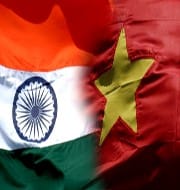Fact Sheet: India-Vietnam Defence Cooperation
Both India and Vietnam attach great importance to defence cooperation. India is one of only three countries with whom Vietnam has a comprehensive strategic partnership. Defence ties between India and Vietnam are guided by the “Common Vision on Defense Ties 2015-20”.
Common Vision on Defense Ties
In 2005, India and Vietnam have signed a Joint Vision Statement on defence cooperation for 2015-2020. The five year Joint Vision statement builds on the earlier mechanisms of cooperation and processes between the two nations for elevating the defence and security relationship. The Joint Vision statement has given further impetus to the India-Vietnam’s expanding defence and strategic ties. Even though progress has been made toward the vision’s objectives related to joint training and cybersecurity cooperation, substantive weapon sales from India to Vietnam remain unrealized. India has been trying to hasten the matter of weapons transfers to Vietnam via high-level exchanges that seek to address Vietnamese concerns.
Strengthening Defence Cooperation
India is eager to contribute to the deterrent potential of a Vietnam with whom it has significant geopolitical congruence. India also aims at building up its own position as a supplier in the Asian arms market simultaneously. Following steps have been initiated by India in this regard:
- India has offered a $500 million line of credit (LoC) for defence purchases.
- India has also offered Akash surface-to-air missile (SAM), which has a range of 27 kilometers and can achieve speeds in excess of Mach 2. Since Akash has more than 90% indigenous content India can transfer this weapon system to Vietnam without taking into consideration the views of a third party like Russia, which co-developed the BrahMos.
- India’s Bharat Electronics (BEL), opened its first-ever representative office in Hanoi with the objective of marketing the company’s weapons systems, radar systems, naval systems, military communication systems, electronic warfare (EW) systems, combat management systems and coastal surveillance systems.
- Cooperation in the sphere of cyber security is epitomized by the Army Software Park in Nha Trang, which is being built with Indian financial support to the tune of $5 million.
- Both India and Vietnam are also looking at the proposal under which India would train Vietnam People’s Air Force (VPAF) pilots on their Su-30 MK2Vs which are similar to the Su-30 MKIs operated by the IAF. The cooperation aims at increasing Vietnam’s ability to fight, if deterrence were to break down.
- The Indian Navy has been training Vietnamese sailors to operate the Vietnamese People’s Navy’s (VPN’s) Kilo-class submarines at Visakhapatnam since 2013.
- An order for building 10 high-speed patrol vessels for the Vietnamese Border Guards is being executed by India’s Larsen & Toubro under the aegis of a $100 million LoC extended by India.
- India is also a front runner for upgrading two Vietnamese Petya-class frigates for which it had supplied spares in the past.
India hopes that persistent efforts will bear fruit in the near future. Hopes are particularly high because the coming into effect of the U.S. Countering America’s Adversaries through Sanctions Act (CAATSA) has made the Vietnamese both wary of depending too much on the Russians or switching over to the Americans as a supplier.
It is said that Indian capacity building assistance to Vietnam as a symmetric response to China’s close military relationship with Pakistan. China is making intermittent noises about the India-Vietnam defense relationship. But the India- Vietnam defence cooperation is not centered on China even though it provides an added advantage of containing China.
Month: Current Affairs - December, 2018


